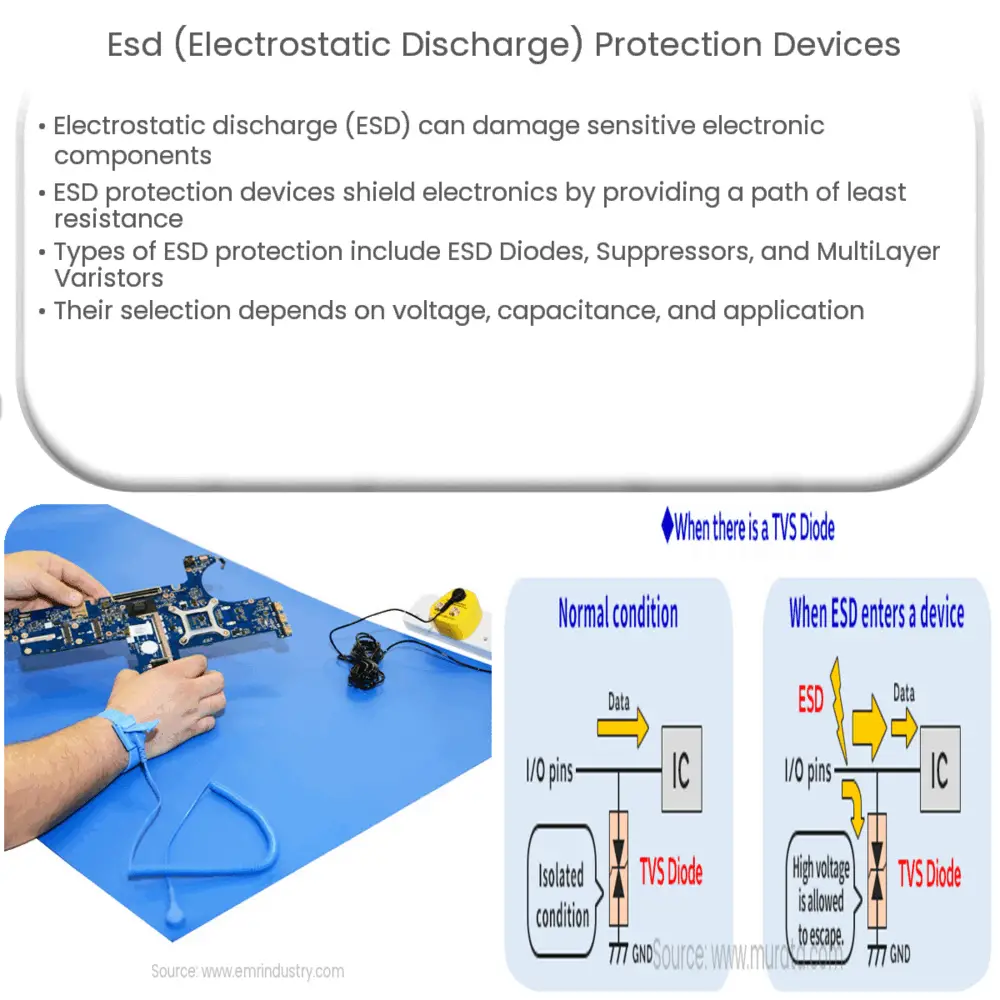Explore the importance of Electrostatic Discharge (ESD) protection devices, their types, selection criteria, and common applications.

Understanding ESD (Electrostatic Discharge) Protection Devices
Electrostatic discharge (ESD) is a phenomenon where a sudden flow of electricity occurs between two electrically charged objects caused by contact, an electrical short, or dielectric breakdown. This often occurs when the surface of an insulating material, like human skin or the surface of a plastic tool, gains an excess charge and discharges it onto a conductive object, such as an electronic device.
The Need for ESD Protection
Without suitable protective measures, ESD can have damaging effects on electronic equipment, particularly those with sensitive electronic components. Even a minute discharge, such as that generated from human touch, can potentially damage or destroy integrated circuits or other elements of an electronic system.
ESD Protection Devices: The Shield Against Electrostatic Discharge
ESD protection devices are essential in managing these risks. They protect sensitive electronics by providing a path of least resistance, directing the electrostatic discharge away from vulnerable parts of the system.
Types of ESD Protection Devices
-
ESD Diodes: ESD diodes are specifically designed to protect electronics apparatus from damage or latch-up due to ESD, lightning, and other voltage-induced transient events. They function by becoming a short circuit when voltage exceeds a certain level, shunting harmful excess charge away from sensitive components.
-
ESD Suppressors: These devices serve a similar function to ESD diodes but are particularly designed to clamp the voltage to a safe level rapidly. In doing so, they protect the equipment from harmful energy pulses.
-
MultiLayer Varistors (MLVs): These are ceramic semiconductor devices designed to protect against overvoltage transients such as ESD. They have the advantage of handling high-current pulses and maintaining low leakage currents at elevated temperatures.
Choosing the right ESD protection device depends largely on the application. Considerations such as operating voltage, capacitance requirements, packaging, and cost are all important factors.
Key Parameters for Selecting ESD Protection Devices
While there are several types of ESD protection devices available, the appropriate choice largely depends on a few key parameters.
-
Breakdown Voltage: This is the voltage at which the device starts to conduct current to divert the ESD. It is essential that this is higher than the maximum operating voltage of the device to avoid false triggering.
-
Clamping Voltage: This is the voltage that appears across the ESD protection device during the ESD event. A lower clamping voltage means better protection as less voltage will be exposed to the sensitive component.
-
Capacitance: For high-speed data lines, the capacitance of the ESD protection device should be as low as possible to avoid signal degradation.
Common Applications of ESD Protection Devices
ESD protection devices find their application in a broad range of sectors. These include:
-
Consumer Electronics: Devices such as smartphones, tablets, and laptops typically employ ESD protection to safeguard their sensitive internal components.
-
Industrial Electronics: In industrial environments, where the risk of ESD is higher due to the presence of various electronic equipment, these devices are particularly essential.
-
Automotive Systems: Modern vehicles are equipped with sophisticated electronics for control, entertainment, and safety functions, all of which require robust ESD protection.
Conclusion
In the face of increasing electronic complexity and sensitivity, ESD protection devices have become a critical part of design considerations in electronic systems. They serve as a necessary guard, ensuring the longevity and reliability of our devices against the unexpected and potentially devastating effects of electrostatic discharge. From the smallest handheld device to complex industrial machinery, the importance of ESD protection cannot be overstated. As we continue to advance in our digital age, the role of ESD protection devices will undoubtedly remain pivotal in safeguarding our electronic investments.

